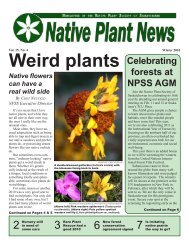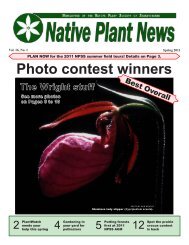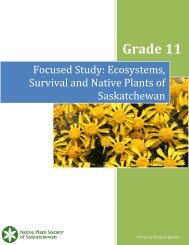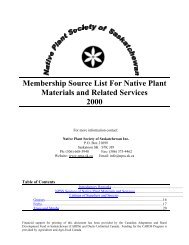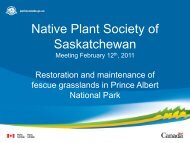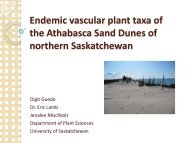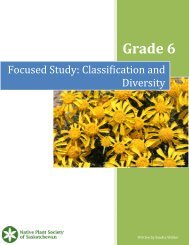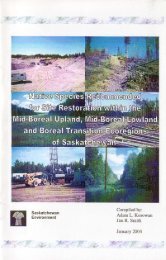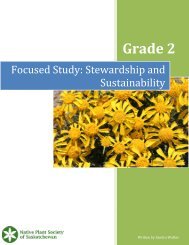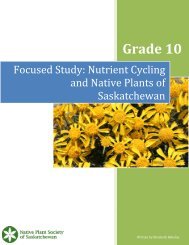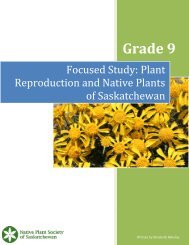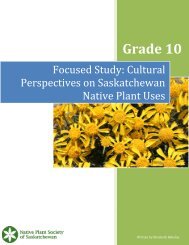Native Plants As Habitat For Wildlife - Native Plant Society of ...
Native Plants As Habitat For Wildlife - Native Plant Society of ...
Native Plants As Habitat For Wildlife - Native Plant Society of ...
You also want an ePaper? Increase the reach of your titles
YUMPU automatically turns print PDFs into web optimized ePapers that Google loves.
Amelanchier alnifolia (saskatoon berry)<br />
Description:<br />
The species name “alnifolia” means alder-like and refers to the alder-like leaves. A<br />
native shrub well known for its berries, the saskatoon also has ornamental value in<br />
flower, fruit, and attractive fall color. It shows tremendous variation in form. Heights<br />
range from 2.6 to 5 m (8 to 15 ft.) with a spread <strong>of</strong> 1.3 to 2.0 m (4 to 6 ft). Dense erect<br />
clusters <strong>of</strong> fragrant white flowers are produced in May, followed by edible dark blue<br />
berries in mid-summer. Used by indigenous peoples and early European settlers as food,<br />
saskatoon berries have become a maior commercial fruit crop on the prairies in the last<br />
decade.<br />
Among the fruiting cultivars are 'Honeywood', 'Northline', 'Pembina', 'Smoky', and<br />
'Thiessen'. 'Altaglow' is a white fruited Saskatoon, columnar in form, with outstanding<br />
gold fall color.<br />
Culture:<br />
Saskatoons grow in a wide range <strong>of</strong> soils in sun or partial shade. They are drought<br />
tolerant once established. If grown within a few kilometres <strong>of</strong> junipers, they may become<br />
infected with saskatoon-juniper rust, especially following warm rainy springs. This<br />
fungal disease is characterized by orange lesions on the leaves and fruit <strong>of</strong> the saskatoon<br />
plants.<br />
Use:<br />
Saskatoons are excellent as part <strong>of</strong> an informal shrub border, as a small specimen tree, or<br />
a tree grouping. They are widely used in shelterbelts. The edible berries are a bonus!<br />
Saskatoons provide cover and food for birds.<br />
Propagation:<br />
Saskatoons are propagated by cuttings, tissue culture, budding or grafting, and by seed.<br />
The first three methods will produce plants which are identical to the parent plants. Seed<br />
is harvested in August and either down directly outdoors in fall or stratified in damp<br />
peatmoss for 5 moths and sown in the spring. <strong><strong>Plant</strong>s</strong> grown from seed will show variation<br />
in form, height and fruiting characteristics (size <strong>of</strong> berry and overall yield <strong>of</strong> plant).<br />
<strong><strong>Plant</strong>s</strong> which are budded or grafted, usually onto cotoneaster rootstock, will be less<br />
productive and have a shorter life span. Etiolated cuttings or tissue culture are the<br />
preferred methods <strong>of</strong> propagation.<br />
34



